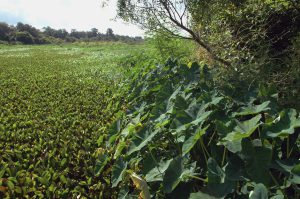Florida crawls with invasive species: Burmese pythons, water hyacinths, Brazilian peppertrees. By taking a few precautions, we can lower the chances an animal or plant becomes invasive, says a University of Florida expert.
Earlier this month, we heard about the Giant African land snail. After the Florida Department of Agriculture and Consumer Services positively identified the snail, it placed part of Pasco County under an agricultural quarantine.
Before scientists classify species as “invasive,” they deem them “nonnative,” which means they don’t originate in the Sunshine State. Through a series of steps, some of them might become invasive, said Deah Lieurance, an Extension scientist at the UF/IFAS Center for Aquatic and Invasive Plants.
To become an invasive species, a nonnative species must cause — or be likely to cause — economic harm or endanger human health. To reach that classification, species move through five stages of human-aided biological invasion:
- Transport — Moving beyond its native boundaries.
- Introduction — Intentional or accidental introduction into the wild.
- Establishment – When the species reproduces and becomes capable of surviving in the wild.
- Spread – The offspring are dispersed to establish new populations.
- Negative impacts – The species causes significant changes to ecological processes, economic costs or losses, threats to human health.
“We believe that informing the general public how this process happens will help them understand that invasive species are the consequence of human activities,” said Lieurance, lead author of a new UF/IFAS Extension document on the topic.

“Making informed choices about what nonnative plant species they use for their landscape or keep as pets, inspecting and cleaning recreational equipment, disposing of nonnative species responsibly and other actions can stop the spread before the species makes it to that final stage — invasive,” she said.
Invasive species can cause several types of damage, including ecological, economic and human.
Ecological impact
An example of ecological impact comes from the Melaleuca trees in the Everglades. They contain high concentrations of flammable volatile oils that can fuel intense fires. Such blazes kill native plants and trigger the release of millions of melaleuca seeds that can recolonize the area after the fire, Lieurance said.
Economic damage
A recent economic analysis has conservatively quantified costs of invasive species in the United States since 1960 at $1.22 trillion in damages and management costs. The annual cost of invasive plants, animals and diseases in losses to Florida’s agriculture is estimated at $179 million.
Human Health
Invasive species such as the Asian tiger mosquito (Aedes albopictus) and yellow fever mosquito (Aedes aegypti) can spread viruses, such as West Nile, Zika and dengue to humans.
To stop spreading invasive species, Lieurance suggests you make well-informed choices:
- Clean your boots and boats before moving to a new recreation area.
- Make sure you don’t pack a pest when traveling. Check with the U.S. Department of Agriculture to see what food or plants you can bring into the country and make sure you declare all agricultural products on your U.S. Customs forms.
- Get rid of garden waste responsibly.
- Do not release bait, aquarium fish or exotic pets into the wild.
- Make good choices when choosing plants for landscaping by visiting the UF/IFAS Assessment, which provides evidence-based recommendations on over 900 nonnative plant species.
- Finally, check with the Florida Fish and Wildlife Conservation Commission to make sure that pet you might want to purchase is legal in the state or if your desired pet requires a permit to possess.
It’s important to note, said Lieurance, that many nonnative species don’t ever become invasive, and they actually benefit humans.
“Still, the most logical solution is to stop this process before it starts. My research and Extension efforts strive to accomplish this by conducting risk assessments on nonnative plants before they enter Florida, completing a horizon scan to identify invasive species threats that might be sitting in a blind spot and not on our radar, and communicating to Floridians the benefits of prevention,” she said.
###
ABOUT UF/IFAS
The mission of the University of Florida Institute of Food and Agricultural Sciences (UF/IFAS) is to develop knowledge relevant to agricultural, human and natural resources and to make that knowledge available to sustain and enhance the quality of human life. With more than a dozen research facilities, 67 county Extension offices, and award-winning students and faculty in the UF College of Agricultural and Life Sciences, UF/IFAS brings science-based solutions to the state’s agricultural and natural resources industries, and all Florida residents.
 24
24
